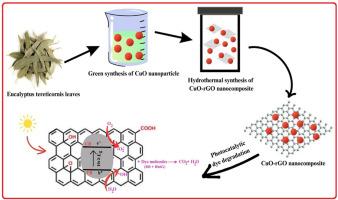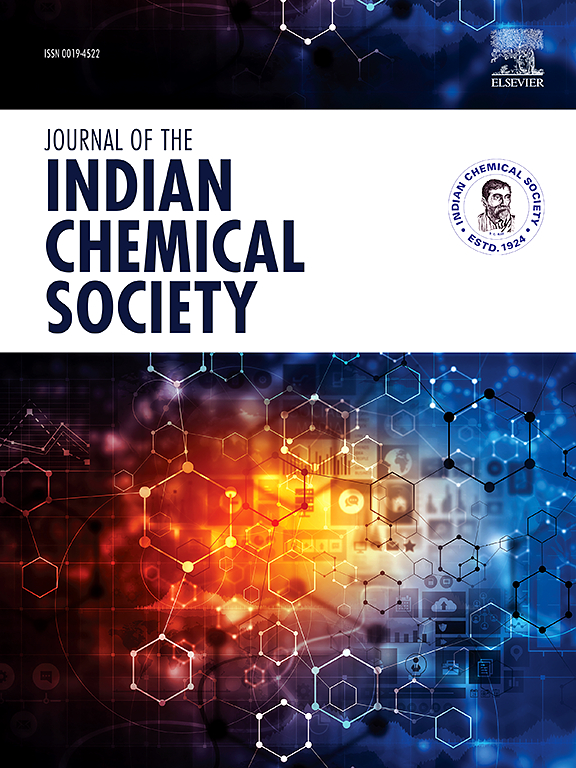A sustainable strategy to improve photocatalytic degradation properties of CuO and CuO-rGO nanocomposite using Eucalyptus leaf extract
IF 3.2
4区 化学
Q2 CHEMISTRY, MULTIDISCIPLINARY
引用次数: 0
Abstract
In this study, Copper oxide (CuO) nanoparticles were synthesized using a sustainable approach. The process comprised Eucalyptus leaf extract as both a biological capping agent and a reducing agent. The synthesis process used a one-pot hydrothermal technique to efficiently combine CuO nanoparticles with reduced graphene oxide (rGO). Analytical methods were utilized to investigate the prepared nanocomposite's structural, crystalline, morphological, functional, optical, and thermal characteristics. The prepared sample was analyzed using X-ray diffraction, which revealed that CuO nanoparticles have a monoclinic crystal structure, and no impurity peaks were observed. Field emission scanning microscopes displayed the uniform dispersion of spherical CuO nanoparticles with layered and non-agglomerated, resembling a sponge-like structure of rGO. The microstructural analysis also confirmed the dispersion of copper inside reduced graphene oxide (rGO) sheets. The optical properties, including light absorption and bandgap width, were investigated using UV–visible spectroscopy using bandgap energies of 2.5 and 2.8 eV. In addition, the nanocomposite's ability to degrade cationic Rhodamine 6G and anionic Rose Bengal dyes by photocatalysis was evaluated. The degradation of RB and Rh6G dyes was characterized by nanocatalysis using UV–visible spectroscopy and a pseudo-first-order kinetics model. The pseudo-first-order degradation kinetic rate of Rhodamine 6G was determined to be 2.55 x 10−2 min−1, indicating that the nanocomposite effectively initiates this dye's degradation. The results showed that dye degradation was effective even at reduced catalyst concentrations.

利用桉树叶提取物改善 CuO 和 CuO-rGO 纳米复合材料光催化降解特性的可持续战略
本研究采用可持续方法合成了纳米氧化铜(CuO)颗粒。该工艺由桉树叶提取物作为生物封端剂和还原剂。合成过程采用一锅水热技术,有效地将氧化铜纳米粒子与还原型氧化石墨烯(rGO)结合在一起。利用分析方法研究了所制备纳米复合材料的结构、结晶、形态、功能、光学和热学特性。利用 X 射线衍射分析了制备的样品,结果表明 CuO 纳米粒子具有单斜晶体结构,且未观察到杂质峰。场发射扫描显微镜显示,球形 CuO 纳米粒子均匀分散,具有分层和无团聚的特点,类似于 rGO 的海绵状结构。微观结构分析也证实了铜在还原氧化石墨烯(rGO)片中的分散。利用带隙能量为 2.5 和 2.8 eV 的紫外可见光谱分析了其光学特性,包括光吸收和带隙宽度。此外,还评估了纳米复合材料通过光催化降解阳离子罗丹明 6G 和阴离子玫瑰红染料的能力。利用紫外可见光谱和伪一阶动力学模型对纳米催化降解 RB 和 Rh6G 染料的过程进行了表征。经测定,罗丹明 6G 的伪一阶降解动力学速率为 2.55 x 10-2 min-1,表明纳米复合材料能有效地启动该染料的降解。结果表明,即使在催化剂浓度降低的情况下,染料降解也是有效的。
本文章由计算机程序翻译,如有差异,请以英文原文为准。
求助全文
约1分钟内获得全文
求助全文
来源期刊
CiteScore
3.50
自引率
7.70%
发文量
492
审稿时长
3-8 weeks
期刊介绍:
The Journal of the Indian Chemical Society publishes original, fundamental, theorical, experimental research work of highest quality in all areas of chemistry, biochemistry, medicinal chemistry, electrochemistry, agrochemistry, chemical engineering and technology, food chemistry, environmental chemistry, etc.

 求助内容:
求助内容: 应助结果提醒方式:
应助结果提醒方式:


